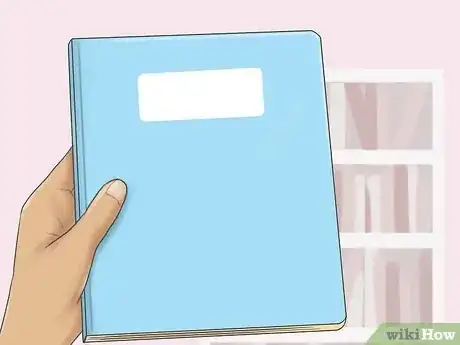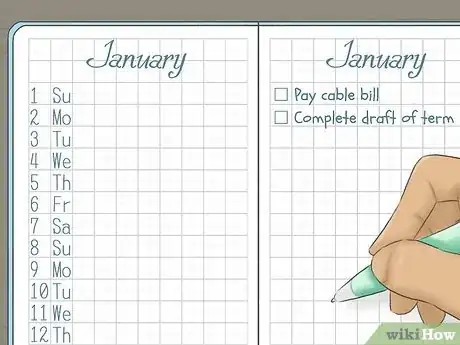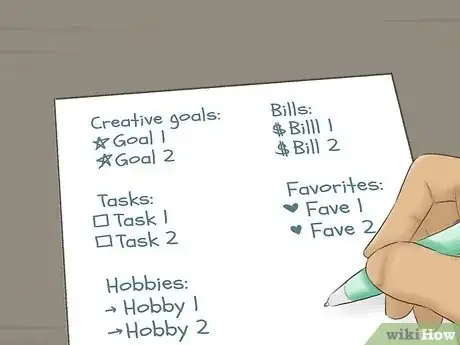This article was co-authored by Claire Donovan-Blackwood and by wikiHow staff writer, Janice Tieperman. Claire Donovan-Blackwood is an Arts & Crafts Specialist and CEO of Heart Handmade UK, a site dedicated to helping people live a happy, creative life. With over 13 years of experience, Claire uses art as a form of therapy and focuses on mindfulness in the making of art. She makes crafting easy and accessible for those she works with. Claire received her B.A. in Photography & Visual Imagery from The University of Huddersfield.
There are 7 references cited in this article, which can be found at the bottom of the page.
wikiHow marks an article as reader-approved once it receives enough positive feedback. This article has 24 testimonials from our readers, earning it our reader-approved status.
This article has been viewed 469,329 times.
These days, it seems like bullet journaling is all the rage… but what exactly is it? At its core, a personal bullet journal is a quick and flexible system that offers tons of organizational benefits to your everyday life. With daily-, monthly-, and future-focused logs, you can use your journal to concentrate on what’s most important in both the present and future. Your bujo doesn’t have to stop there, though—with just a little prep work, your bullet journal can be anything and everything you want it to be. We’ll walk you through everything you need to know, so you can embark on your very own bujo journey.
Things You Should Know
- Choose any kind of notebook to serve as your bullet journal. It doesn’t need to be fancy or divided into sections, since you’ll be organizing the journal on your own.
- Start off your journal with an index section, followed by a future log, monthly log, and daily log.
- Keep your journal organized with signifiers—these are specialized bullet points that help you keep your thoughts categorized.
- Customize your journal with collections, like a list of books you want to read or recipes that you want to try out.
Steps
Core Journal Setup
-
1Pick the right notebook. Believe it or not, you don’t need a fancy notebook to bullet journal—all you actually need is a notebook that you can easily transport from place to place. Any type of notebook can get the job done, like a notebook with an elastic, or even a Moleskine notebook. A decorative notebook, or one with existing sections, is not necessary for bullet journaling since you'll be doing all the organizing on your own.
- You can personalize the notebook a bit if you’d like, though! If you love the color blue, for instance, you could invest in a blue notebook.
- You don't have to stick to lined notebooks, either. You could work with dotted notebooks, grid notebooks, and blank notebooks. It's all up to you!
- The official Bullet Journal brand sells a great bullet journal made with the LEUCHTTURM1917 notebook.
-
2Create an index. Bullet journal pages are designed to be numbered and tracked in an index. This index helps you track which sections fall on which pages. The first blank spread (the first two blank pages that fall side by side) will be your index. To get started, simply write "Index" on the top of both pages.[1]
- You can write in pen or pencil using whatever color you’d like. A pen may show up better, however, and darker colors are typically easier to read.
Advertisement -
3Make your future log. Flip to the next blank spread in your journal—this will be your future log. Your future log is a way of getting a bird's eye view of tasks you need to complete within the next six months.[2] It will include a month-by-month breakdown of events, tasks, and goals. To start, divide each page into 3 even vertical sections. Use a ruler to draw three straight lines down the spread, dividing it into three equal sections on each page.[3]
- For example, if each page has 24 lines make three sections on each page of 8 lines each.
-
4Write the name of the next six months in each section. Let’s say you're starting your bullet journal for the new year. You would write, "January" in the first box, then "February," and so on. If you were starting your bullet journal in May, you’d write “May” in your first box, followed by “June,” “July,” and so on.[4]
- Be sure to write page numbers on the corners of each page. As your future log in your first section, the page numbers should be one and two. Flip back to your index and write something like, "Future Log . . . 1-2."
-
5Add a monthly log. Flip to the next blank spread in your journal—this will be your monthly log, which gives you an overview of the upcoming month. Start with the current month and write the name of this month on the top of both pages. On the left page, write down every date of the month. After you finish, write down the abbreviation of the day of the week next to the number. On the right page, jot down your task list for the month, using bullet points to make a list of all the goals you hope to complete, any bills you have to pay, and any deadlines you need to meet. [5]
- For example, on the left page you would write "January 1st, Sun."
- On the right page, you would write things like "Pay the cable bill," and "Complete draft of term paper."
-
6Add a daily log. Flip to the next blank spread and write today's date on the top of the page. Use small bullet points to write down things you need to do that day, tasks you completed, and anything else interesting that’s going on. Use as many lines as you need to log your daily activities. When the day ends, make a new entry in the line below for the next day.[6]
- A bullet journal is meant to be brief, so try to use short, simple sentences. For example, something simple like do not say, "Called vet to ask about cat's vaccinations. Rabies due." would be better than "Today, I called the vet to discuss the cat's vaccinations, including the rabies vaccines that is due."
-
7Update your index. When you're done, write page numbers on the corner of each page. Flip back to your index and add your monthly log to your index. For example, you could write "January Monthly Log... 3-4."[7]
Journal Customizations
-
1Choose signifiers that work for you. Signifiers are the types of bullet points you use in your journal to help categorize your content. There are no set rules about establishing signifiers—it heavily depends on the types of events you choose to journal. Feel free to break down events into categories, such as work, school, bills, personal, creative projects, etc. Each type of event should have a different bullet point signifying its type, but it's best to only use a few categories to keep things from getting confusing.[8]
- For example, creative goals could be signified with a star, work could be signified by a simple bullet point, hobbies could be signified by an arrow, bills could be signified by a small dollar sign, and personal topics could be signified by a heart.
- As you track your goals on your daily calendar, use your signifiers to keep things organized! For example, an entry may look something like, "$ Paid Cable Bill today."
-
2Organize your monthly goals into categories. It can also help to categorize monthly goals in your monthly log. Instead of having a random list of bullet points lumping everything you need to do together, organize further. It helps to separate your tasks by type.
- For example, you could write headings like "Weight and Fitness Goals," "Deadlines and Due Dates," "Work Goals," and "Creative Goals."
- From there, write down tasks under their corresponding categories. Under "Weight and Fitness Goals," for example, you could write something like, "Visit the gym 12 times this month."
-
3Store collections in the back of the journal. Collections are broad to-do lists that you want to accomplish for a year. It includes anything that is not a log—for example, collections can include books you want to read, movies and TV shows you want to watch, recipes you want to try, and so on. It's good to fill out your collections page as ideas strike you, and you can refer to it later on when you need inspiration.[9] Here are a few collection ideas to get you started
- Books to read
- Habit tracker
- Places you want to visit
- Food diary
- Meal prep log
- Inspiring quotes
- Daily affirmations
- Budget
-
4Fill out daily events that matter to you. As you track your daily log, fill out events according to your preference. This depends heavily on why you're keeping the bullet journal. If it's primarily to organize work goals, for example, you can track what occurred at work each day. However, the journal does not have to be super professional—feel free to record personal moments that made you smile. For instance, "Boyfriend brought me coffee during my lunch break."
- Remember to make use of your signifiers as you fill out your journal.
-
5Jazz up your journal with fun decorations. Want to give your bujo a little more personality? Stickers, washi tape, and markers are just a few ways to add plenty of creativity and life to your journal. Here are a few other ideas to help you get started:[10]
- Write out your spreads using cool fonts
- Apply fun patterns to your journal with rubber stamps
- Adorn your journal pages with doodles
- Add a touch of watercolor paint to your pages
Using and Updating Your Journal
-
1Cross off items as you complete them. Each time you complete a task, flip back to your monthly log. Cross off the task on your broad to-do lists. This can help you track what you have accomplished and what you still need to accomplish for a given month.[11]
-
2Transfer important uncompleted tasks to the next month. At the end of each month, review your monthly log and daily log. See which tasks you have completed and which still need to be done. Set up a new monthly and daily log, the same way you did before, transferring the uncompleted tasks to the next log as you go.[12]
- Keep in mind that you do not need to transfer all your tasks to the next month. If you see a task that's no longer worth your time or that is too late to complete, cross it out. This will help you stay organized by trimming down unnecessary information.
-
3Add long-term goals to your future log. With a bujo, it’s a good idea to continue building on your future log over time. As you glance through your daily and monthly logs for the past month, see what long-term tasks are included. For example, if you're working on a graduate thesis, it will likely pop up in your logs over time. Feel free to add things to your future log as necessary.[13]
- For example, break down your thesis into small goals and jot them down in your future log. In February, you would write "Complete draft" and in March write "Revise draft."
-
4Make notes on projects specific to you. It helps to eventually make a project log or list in the back of your bullet journal—this can help you track long-term projects. You can make a list that says something like "Yearly Projects." When reviewing each monthly log, flip back to this list. This will remind you of any short-term goals regarding longstanding projects you should add to each month.
- For example, if a long-term goal is to be able to run 30 minutes without stopping for one month, you could write, "Increase running time to 15 minutes."
Bullet Journal Help
Expert Q&A
Did you know you can get premium answers for this article?
Unlock premium answers by supporting wikiHow
-
QuestionHow do I decorate a bullet journal?
 Claire Donovan-BlackwoodClaire Donovan-Blackwood is an Arts & Crafts Specialist and CEO of Heart Handmade UK, a site dedicated to helping people live a happy, creative life. With over 13 years of experience, Claire uses art as a form of therapy and focuses on mindfulness in the making of art. She makes crafting easy and accessible for those she works with. Claire received her B.A. in Photography & Visual Imagery from The University of Huddersfield.
Claire Donovan-BlackwoodClaire Donovan-Blackwood is an Arts & Crafts Specialist and CEO of Heart Handmade UK, a site dedicated to helping people live a happy, creative life. With over 13 years of experience, Claire uses art as a form of therapy and focuses on mindfulness in the making of art. She makes crafting easy and accessible for those she works with. Claire received her B.A. in Photography & Visual Imagery from The University of Huddersfield.
Arts & Crafts Specialist There are many different things you can do. For example, search online for a "magic reflector" that reflects photos from your phone onto your bullet journal so you can draw them perfectly. You can also use Rebel Soul embellishments, which are like tattoos for paper — you just rub them on and end up with a cute illustration.
There are many different things you can do. For example, search online for a "magic reflector" that reflects photos from your phone onto your bullet journal so you can draw them perfectly. You can also use Rebel Soul embellishments, which are like tattoos for paper — you just rub them on and end up with a cute illustration. -
QuestionHow do you make a study tracker?
 wikiHow Staff EditorThis answer was written by one of our trained team of researchers who validated it for accuracy and comprehensiveness.
wikiHow Staff EditorThis answer was written by one of our trained team of researchers who validated it for accuracy and comprehensiveness.
Staff Answer wikiHow Staff EditorStaff AnswerSome people like to make a calendar-style style tracker where they note how much they studied per day each month. Others prefer to take a more in-depth approach by color-coding their classes and tracking their study time for each class per week. For inspiration, look up different study trackers on image searching sites like Pinterest and see if any of them catch your eye.
wikiHow Staff EditorStaff AnswerSome people like to make a calendar-style style tracker where they note how much they studied per day each month. Others prefer to take a more in-depth approach by color-coding their classes and tracking their study time for each class per week. For inspiration, look up different study trackers on image searching sites like Pinterest and see if any of them catch your eye. -
QuestionDo handmade bullet journal work best? Because I have already made one.
 wikiHow Staff EditorThis answer was written by one of our trained team of researchers who validated it for accuracy and comprehensiveness.
wikiHow Staff EditorThis answer was written by one of our trained team of researchers who validated it for accuracy and comprehensiveness.
Staff Answer wikiHow Staff EditorStaff Answer
wikiHow Staff EditorStaff Answer
References
- ↑ https://researchguides.stevens.edu/bulletjournal#s-lg-box-17773774
- ↑ https://researchguides.stevens.edu/bulletjournal#s-lg-box-17773774
- ↑ https://artincontext.org/how-to-bullet-journal/
- ↑ https://artincontext.org/how-to-bullet-journal/
- ↑ https://www.cnet.com/health/how-to-start-bullet-journaling-for-an-organized-2021/
- ↑ https://www.cnet.com/health/how-to-start-bullet-journaling-for-an-organized-2021/
- ↑ https://www.aarp.org/home-family/your-home/info-2019/bullet-journal.html
- ↑ https://london.sunderland.ac.uk/about/news-home/growth-mindset/bullet-journaling/
- ↑ https://www.cnet.com/health/how-to-start-bullet-journaling-for-an-organized-2021/
About This Article
To bullet journal, first choose an empty journal to write in. Open to the first spread and write “Index” at the top of each page. This will be the index of your journal. Open to the next spread and count the number of lines on one of the pages. Divide that by 3, then draw 3 horizontal lines across the spread to divide it into 6 equal sections, 3 on each page. Write the name of the next 6 months so there’s one month at the top of each section. Then write “Future Log” at the top of each page. This will be the future log of your journal where you keep track of tasks you need to complete within the next 6 months. Open to the next spread and write the current month at the top of each page. Write each day of the month on the left side of the left page from top to bottom. Add the abbreviation for the day of the week to the right of each date. This will be the monthly log where you write down upcoming tasks for the month. The tasks go on the right page of the log. Open to the next spread and write today’s day at the top of the page and a bullet point list of things you need to do today underneath it. When the day ends, make a new entry for the next day below it. Once you’ve added an entry for each day of the week, flip to a new spread and add entries for the following week as it progresses. Add page numbers to the bottom left corner of every page in your bullet journal, and add each number and the name of the corresponding log to the index. When you’re adding items to your daily log, put a bullet point next to tasks, a circle next to events, and a line next to notes. If a task is really important, put a star next to it. At the end of each month, add a new monthly log to the next open spread. Then, cross out all the tasks in your daily logs that you completed. If there are any uncompleted tasks that are still worth doing, draw a right arrow next to them and add the tasks to your new monthly log. If a task is due in months, draw a left arrow next to it and add that task to the corresponding month in the future log. If you have multiple related tasks, add a collection to your journal to keep them organized. Open to a new spread and write the name of a topic at the top of the page. List all of the related tasks underneath. Then add the new collection to your index. As you continue to bullet journal, you can create custom logs, collections, and signifiers that work best for you. For details about how to organize your notebook, keep reading.
















































































